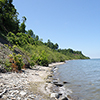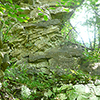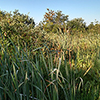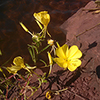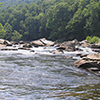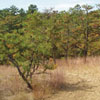Conservation Science
Protecting Pennsylvania’s Plants and Animals
Vernal Pools
Pennsylvania is a diverse state rich with forests, streams and wetlands. Nestled inside our forests you will often encounter small wetlands known as vernal pools. Most vernal pools perform a magic trick each year, vanishing during the heat of high summer and returning during the cool rains and snows of fall, winter and spring. The Western Pennsylvania Conservancy protects vernal pool habitats through its research and inventory, landowner outreach, public education, land acquisitions and easements, and partnerships with other organizations.
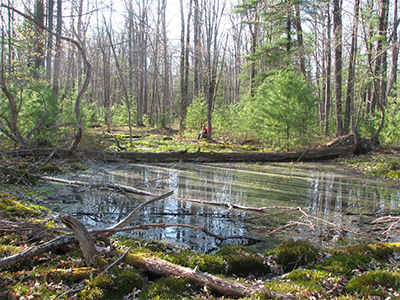
How Do Vernal Pools Develop?
Pennsylvania’s geologic diversity can be seen in the different ways our vernal pools form. In our non-glacial regions of the state, vernal pools are found in floodplains and poorly drained soils in lowlands. In the South Mountain region, you can find thousands of sag ponds. These ponds form where limestone bedrock melts away over time and the overlying soils sink into the depressions that form beneath the surface.
In the Ridge and Valley region, vernal pools are seen at the toeslopes of hills, and in more unexpected places, such as on the tops of ridges, especially on level benches where headwater streams begin. In glacial regions in the northeast and northwest corners of the state, many vernal pools are located in the depressions that formed through actions of ice melt, scour and erosion. In periglacial regions, you can find pingos, which form in the headwaters of mountainous areas where moist soils freeze, thaw and slowly slide downslope, forming crescent-shaped basins.
Vernal Pool Habitat
Vernal pools provide food, water or shelter for all kinds of wildlife in the forest. But they are most critical to a unique group of animals that breed in fishless waters. In Pennsylvania there are six amphibians and two types of crustaceans that use vernal pools almost exclusively for breeding and larval development. These indicator species require vernal pools for breeding habitat and development of their young. The adult amphibians spend most of the year in the forest surrounding the vernal pool wetland. They can travel a thousand feet or more between the breeding pool and their upland homes where they live most of the year.
Vernal pool indicator species include: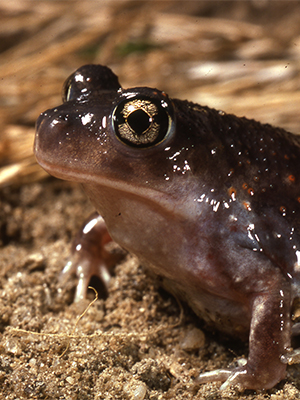
- Marbled Salamander (Ambystoma opacum)
- Spotted Salamander (Ambystoma maculatum)
- Jefferson Salamander (Ambystoma jeffersonianum)
- Blue-spotted Salamander (Ambystoma laterale)
- Wood Frog (Lithobates sylvaticus)
- Eastern Spadefoot (Scaphiopus holbrooki)
- Fairy Shrimp (Eubranchipus spp.)
- Clam Shrimp: Euroamerican clam shrimp (Limnadia lenticularis), diversity clam shrimp (Eulimnadia diversa)
Vernal Pool Conservation
through Land Protection
Wolf Creek Narrows Natural Area
WPC first purchased 100 acres in Butler County in 1979, now known as Wolf Creek Narrows Natural Area. The site is famous for its spectacular display of spring wildflowers. The uppermost terrace of the Wolf Creek floodplain rarely floods and has a series of floodplain pools. They provide breeding habitat for spotted salamanders, wood frogs, fairy shrimp and numerous other invertebrates.
Jennings Environmental Education Center
WPC protected the first parcel of what we know today as the Jennings Environmental Education Center in 1952. WPC acquired additional land in the 1960s and eventually transferred the 310-acre property to the Pennsylvania Bureau of State Parks. The reserve encompasses forest, a portion of Big Run stream, a relict prairie, a fen and a series of vernal pools.
Jennings’ vernal pools vary in depth; some are unvegetated blackleaf pools, while others have lush emergent marsh vegetation. The pools provide breeding habitat for wood frogs and spotted salamanders.
Landowner Outreach
Individual landowners can play a critical role in the protection of vernal pools. Since 2009, WPC biologists have visited wetlands on private properties throughout the state to help landowners identify vernal pools and catalog the wildlife using their wetlands. This allows us to provide voluntary management recommendations to protect and improve the health of their wetlands.
This work was accomplished, in part, thanks to grants through the Community Conservation Partnerships Program (C2P2), Keystone, Recreation, Park and Conservation Fund, which is administered by the PA Department of Conservation and Natural Resources, Bureau of Recreation and Conservation.
Thanks to a new C2P2 grant, this service will be available again to private landowners in Pennsylvania with vernal pools in their property (grant duration 2018-2020). This service is available to private landowners in Pennsylvania with vernal pools on their property. Landowners who wish to participate in the program will be asked to list and prioritize land use goals for their properties. Our biologists will write management plan that recommends specific best management practices the landowner can use to protect the property’s vernal pools and the surrounding upland habitat while accomplishing other land use goals. There are no fees or commitments associated with this program, just non-binding advice provided by wildlife professionals. If you would like to have a vernal pool management plan developed for your property, please contact Betsy Leppo (Harrisburg office) or JoAnn Albert (Pittsburgh office).
The Waldmans, landowners in York County, have been working hard to increase the diversity of plants in a variety of habitats on their property to attract wildlife. Portions of their wetlands along a creek floodplain were overtaken by invasive species such as reed canary grass (Phalaris arundinacea), Japanese hops (Humulus japonicas) and mile-a-minute (Persicaria perfoliata). With recommendations provided by WPC and other conservation partners and an NRCS EQIP grant, the Waldmans implemented a variety of techniques to control invasive species on their property. They applied wetland approved herbicides during the dry season and used prescribed fire in a vernal pool that was previously a solid stand of reed canary grass. Today, it is apparent that their efforts are paying off. Native plant seeds that were previously smothered by a thick thatch of dead reed canary grass were uncovered and sprouted in abundance from the existing seed bank.
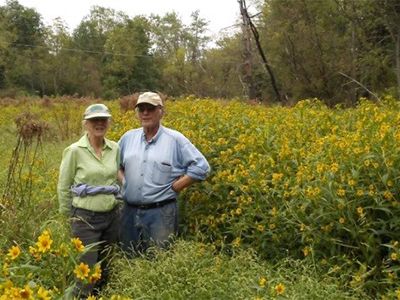
The Grosses are forward thinking private landowners in Lycoming County who explored different conservation options to protect their vernal pools. In 2010, the Grosses invited WPC to visit their vernal pools and create a voluntary management plan for the wetlands. WPC biologists confirmed the wildlife value of their high quality vernal pool complex. The property is now protected under an easement through the Merrill Linn Land and Waterways Conservancy. The Grosses are working with an experienced conservation forester to promote a healthy, mature and diverse stand of trees through light and selective thinning. They will implement best management practices during timber harvest to protect the integrity of the vernal pool wetlands and their wildlife. Profits of timber harvest will be used in part to start an endowment that can fund conservation activities on the property in the future. Read more about this beautiful preserve and the unique way the landowners are protecting, managing, and sharing it with students and lovers of nature at the Glacier Pools Preserve website.
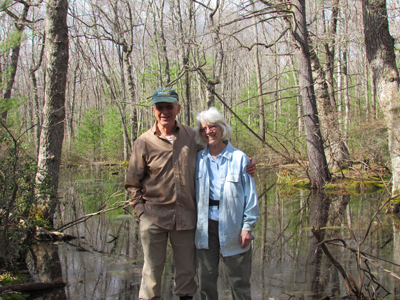
Vernal Pool Partnerships
The Nature Conservancy is very active in land conservation in the Minsi Lake Corridor, a region of exceptional vernal pool abundance. TNC used inventories and landowner management plans developed by WPC to identify conservation priorities and guide their work with landowners to develop and define the terms of conservation easements.
WPC also worked with the Abington Township Shade Tree Commission in Montgomery County as they developed a land management plan for the Ardsley Wildlife Sanctuary. WPC staff provided a site visit and wetland management plan that can be used to guide site planning and their work to improve to the park’s entryways, trails, woodlands and wetlands.
The Fern Hollow Nature Center and Friends of the Little Sewickley Creek Watershed Association requested assistance from WPC staff as they developed a wetland restoration plan for a site in Allegheny County. In the fall of 2015 they implemented their Bell Acres/Sewickley Heights Borough Park vernal pool wetland restoration project with funding assistance from the Allegheny County Conservation District.
Gifford Pinchot State Park Vernal Pool Restoration
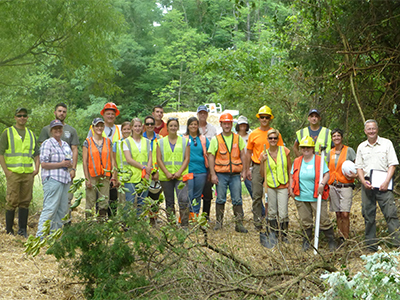 Conservancy staff coordinated a project to restore several areas at Gifford Pinchot State Park that held water for a short period in the spring. Although vernal pool amphibians were breeding in them, the pools did not hold water long enough for their larvae to develop and exit before the wetland dried up in the summer. We worked with Thomas Biebighauser, wildlife biologist and wetland ecologist at the Center for Wetlands and Stream Restoration, to develop a plan to create functioning wetlands at five sites in 2016.
Conservancy staff coordinated a project to restore several areas at Gifford Pinchot State Park that held water for a short period in the spring. Although vernal pool amphibians were breeding in them, the pools did not hold water long enough for their larvae to develop and exit before the wetland dried up in the summer. We worked with Thomas Biebighauser, wildlife biologist and wetland ecologist at the Center for Wetlands and Stream Restoration, to develop a plan to create functioning wetlands at five sites in 2016.
As part of this project, WPC hosted a two-day workshop for land managers, conservation planners, wildlife biologists, environmental scientists, foresters, hydrologists, engineers, educators and private landowners. Most of the workshop took place at two restoration sites where we discussed how to select locations for building wetlands, test soil texture, choose appropriate construction techniques, work with heavy equipment operators and establish native flowering plants. The Upper Susquehanna Coalition’s skilled wetland work crew operated the heavy equipment needed to restore the wetlands.
This project was made possible with funding from the Amphibian and Reptile Conservancy; the Pennsylvania Department of Conservation and Natural Resources, Bureau of State Parks Resources Management and Field Services Section; and the Community Conservation Partnerships Program, Keystone, Recreation, Park and Conservation Fund, administered by the Pennsylvania Department of Conservation and Natural Resources, Bureau of Recreation and Conservation. We gratefully acknowledge the Pennsylvania Parks and Forests Foundation, the Friends of Pinchot State Park and the staff at Gifford Pinchot State Park for their ongoing support.
For More Information:
Western Pennsylvania Conservancy
800 Waterfront Drive
Pittsburgh, PA 15222

